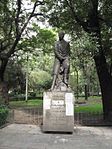
Alexander von Humboldt
Friedrich Wilhelm Heinrich Alexander von Humboldt (14 September 1769 – 6 May 1859) was a German polymath, geographer, naturalist, explorer, and proponent of Romantic philosophy and science.[2] He was the younger brother of the Prussian minister, philosopher, and linguist Wilhelm von Humboldt (1767–1835).[3][4][5] Humboldt's quantitative work on botanical geography laid the foundation for the field of biogeography, while his advocacy of long-term systematic geophysical measurement pioneered modern geomagnetic and meteorological monitoring.[6][7]
For other uses, see Alexander von Humboldt (disambiguation).
Alexander von Humboldt
14 September 1769
6 May 1859 (aged 89)
German
Biogeography, Kosmos (1845–1862), Humboldt Current, magnetic storm, Humboldtian science, Berlin Romanticism[1]
Copley Medal (1852)
Between 1799 and 1804, Humboldt travelled extensively in the Americas, exploring and describing them for the first time from a non-Spanish European scientific point of view. His description of the journey was written up and published in several volumes over 21 years. Humboldt was one of the first people to propose that the lands bordering the Atlantic Ocean were once joined (South America and Africa in particular).
Humboldt resurrected the use of the word cosmos from the ancient Greek and assigned it to his multivolume treatise, Kosmos, in which he sought to unify diverse branches of scientific knowledge and culture. This important work also motivated a holistic perception of the universe as one interacting entity,[8] which introduced concepts of ecology leading to ideas of environmentalism. In 1800, and again in 1831, he described scientifically, on the basis of observations generated during his travels, local impacts of development causing human-induced climate change.[9][10][11]
Humboldt is seen as "the father of ecology" and "the father of environmentalism".[12][13]







![Ferdinand Bellermann. Llaneros (1843). Venezuela.[189]](http://upload.wikimedia.org/wikipedia/commons/thumb/0/01/Ferdinand_Bellermann_001.JPG/88px-Ferdinand_Bellermann_001.JPG)



